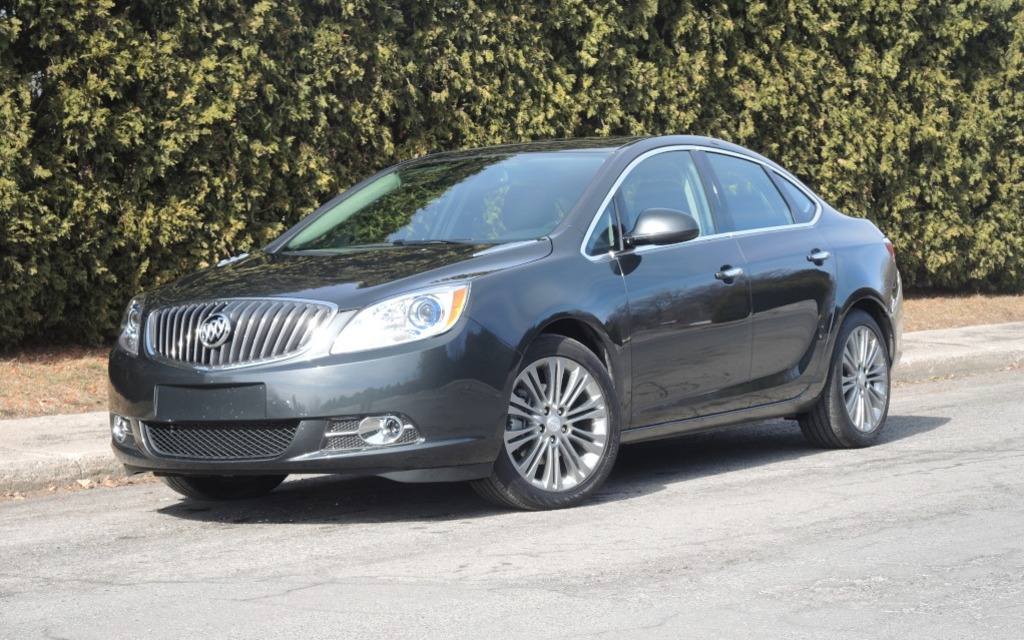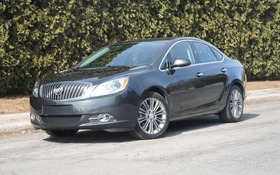2015 Buick Verano Turbo: Quietly Impressive

| Strong points |
|
|---|---|
| Weak points |
|
Concluding that the Buick’s Verano Turbo is nothing more than a pimped, turbocharged version of the Chevrolet Cruze would be a serious error in judgment. Then again, it would be wrong to think that this North American luxury compact surpasses the category’s best German cars, too. In reality, it’s somewhere between the two—and, despite a few glitches, its overall quality may surprise you.
Balanced shape
The last compact we saw from Buick was the Skyhawk, which was was sold from 1975 to 1988. It wasn’t a bad car and its silhouette was fairly stylish for the era, but it was so discrete that it seems to have faded out of memory. The Verano’s design, Turbo or not, is nicer than that. The two versions are set apart only by the Turbo logo on the trunk and by the different alloy wheels. Both feature a balanced silhouette and the waterfall-shaped front grille that doesn’t always harmonize well with other Buick models. To break the monotony of the side panels, there’s a character line that rises just before the wheel well, which isn’t overly prominent to begin with.
To respect the tradition of the brand’s legendary portholes, they included two chrome elements on the hood, each of which is made up of three false openings. It doesn’t add much from a visual standpoint and even looks like an oversight they tried to correct.
The tail end stands out with imposing horizontal lights, while the trunk doesn’t protrude much. Note that this sedan has very short overhangs.
The passenger compartment is luxurious and nicely finished. It seems to have progressed since we last crossed paths with the Verano. The front seats are comfortable – it is a Buick, after all – and the side bolstering is good. Unfortunately, the back seats don’t offer much leg room. If two adults want to sit back there, people in the front seats will have to cooperate. By the way, at 405 litres, the trunk capacity is satisfactory but not exceptional.
The dashboard is user-friendly, with most controls found on the steering wheel spokes or on the central console. However, a lot of people have complained that there are too many buttons, but you get used to it quickly.
We should add that, for 2015, the Verano is offering the OnStar 4G LTE system with integrated Wi-Fi hotspot to help occupants stay connected. You get a three-month trial when you buy the car.
Responsive engine, nifty suspension
The “regular” Verano is propelled by a naturally-aspirated 2.4-litre four-cylinder that produces 180 horsepower and is paired with a six-speed automatic gearbox. The Turbo we test drove came equipped with a 2.0-litre four-cylinder that develops 250 horsepower, which is nothing to sneeze at. It can be paired with a six-speed manual transmission, but the automatic comes at no additional cost. Contrary to what you’d think, the manual transmission adds nothing to the ride because of the stick’s overly long shifting distances and the soft clutch.
Like most cars in this class, the Verano Turbo has a front strut suspension. You may be disappointed to learn that the engineers used the same rear torsion bar suspension as in the Chevrolet Cruze, which shares its platform with the Verano, but Buick’s engineers gave it a Watts Z-link crank that helps centre the rear axle in turns. This configuration reduces lateral forces without encroaching on the trunk. Imagine a longitudinal arm on the rear axle equipped with a Z-shaped hinge in the middle.
Consistent but not sporty
A few kilometres down the road, and the Verano Turbo has already earned a good rep. The suspension is a smidge firmer than on the naturally-aspirated version and the steering is more direct, all of which translates to a more engaging ride. Don’t get me wrong, it’s no BMW 3 Series, but it’s noteworthy just the same.
The engine is powerful enough to get the car from 0-100 km/hr in a little more than six seconds. Even though our test drive took place in Siberian-style cold weather, we still managed to cover the distance in 6.9 seconds (the car was equipped with winter tires, obviously). Buick is promising 6.2 seconds.
This sedan is characterized by an impressively quiet ride. This is thanks to the QuietTuning system, which involves a whole bunch of measures aimed at reducing the sound level in the passenger compartment, thus improving comfort. The windshield is made of acoustic laminated glass, there are triple door seals and the chassis rigidity also adds to the soundproofing. Moreover, a strategically-located microphone in the passenger compartment transmits sounds to an electronic device that uses the audio system to emit inverted sound waves, which in turn mitigates noises.
While we’re on the subject of the interior, the back seats could offer more legroom. However, this trim level makes up for it thanks to its generous factory-standard equipment, comfortable passenger compartment and suspension, and predictable handling.
This is a comfortable, multidimensional car that delivers good performance without being outright sporty. The more you drive it, the more you’ll like it for everyday use.











